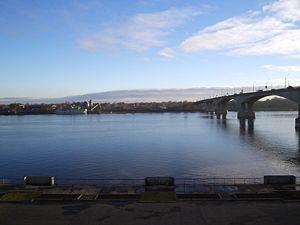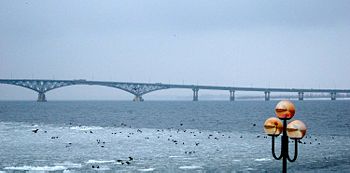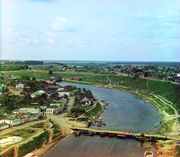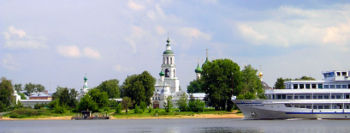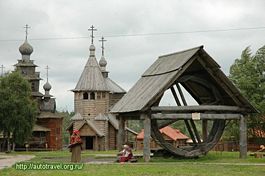Volga River
2008/9 Schools Wikipedia Selection. Related subjects: European Geography
| Volga River (Волга) | |
|---|---|
|
Volga in Yaroslavl (autumn morning)
|
|
| Country | Russia |
| Major cities | Astrakhan, Volgograd, Samara, Kazan, Ulyanovsk, Nizhny Novgorod, Yaroslavl |
| Length | 3,692 km (2,294 mi) |
| Watershed | 1,380,000 km² (532,821 sq mi) |
| Discharge at | Volgograd |
| - average | 8,060 m³/ s (284,636 cu ft/ s) |
| Source | |
| - location | Valdai Hills, Tver Oblast |
| - elevation | 225 m (738 ft) |
| Mouth | Caspian Sea |
| - elevation | -28 m (-92 ft) |
| Major tributaries | |
| - left | Kama River |
| - right | Oka River |
The Volga (Russian: Волга, Tatar Cyrillic: Идел, Latin: İdel) is the largest river in Europe in terms of length, discharge, and watershed. It flows through the western part of Russia, and is widely viewed as the national river of Russia. In fact, eleven out of the twenty largest cities of Russia, including its capital Moscow, are situated in the Volga basin. Some of the largest reservoirs in the world can be found along the Volga.
Nomenclature
The Russian hydronym "Волга" is akin to the Slavic word for "wetness", "humidity" (влага, волога). The Russian name is transliterated as Volga in English and Wolga in German.
The Turkic people living along the river formerly referred to it as Itil or Atil (probably the origin of Attila's name). In modern Turkic languages, the Volga is known as İdel (Идел) in Tatar, Idyll in ancient Chuvash-Bolgar, Атăл (Atăl) in Chuvash, Idhel in Bashkir, and İdil in Turkish. The Turkic peoples associated the Itil's origin with the Kama River. Thus, a right tributary to the Kama river was named the Black Idel.
Another version of the same root is represented by Mari Юл (Jul). Under the Mongols, the river was known by its other Turkic name Sarı-su ("yellow water") but Mongols used also their own name Shar mörön ("yellow river").
The ancient and modern Mordvin name for the Volga, Рав (Rav), apparently reflects the ancient Scythian hydronym *Rhā, supposedly cognate with the ancient Avestan and Sanskrit names Rañha and Rasah for a mythical river supposed to flow around the earth. These Indo-Iranian words are all connected in their primary meaning of "dew, liquid, moisture".
Description
The Volga belongs to the closed basin of the Caspian Sea. Rising in the Valdai Hills 225 meters (738 ft) above sea level north-west of Moscow and about 320 kilometers (199 mi) south-east of Saint Petersburg, the Volga heads east past Lake Sterzh, Tver, Dubna, Rybinsk, Yaroslavl, Nizhny Novgorod, and Kazan. From there it turns south, flows past Ulyanovsk, Tolyatti, Samara, Saratov and Volgograd, and discharges into the Caspian Sea below Astrakhan at 28 meters (92 ft) below sea level. At its most strategic point, it bends toward the Don ("the big bend"). Volgograd, formerly Stalingrad, is located there.
The Volga has many tributaries, most importantly the Kama, the Oka, the Vetluga, and the Sura rivers. The Volga and its tributaries form the Volga river system, which drains an area of about 1.35 million square kilometres in the most heavily populated part of Russia. The Volga Delta has a length of about 160 kilometres and includes as many as 500 channels and smaller rivers. The largest estuary in Europe, it is the only place in Russia where pelicans, flamingoes, and lotuses may be found. The Volga freezes for most of its length during three months of each year.
The Volga drains most of Western Russia. Its many large reservoirs provide irrigation and hydroelectric power. The Moscow Canal, the Volga-Don Canal, and the Volga-Baltic Waterway form navigable waterways connecting Moscow to the White Sea, the Baltic Sea, the Caspian Sea, the Sea of Azov and the Black Sea. High levels of chemical pollution currently give cause for environmental concern.
The fertile river valley provides large quantities of wheat, and also has many mineral riches. A substantial petroleum industry centres on the Volga valley. Other minerals include natural gas, salt, and potash. The Volga Delta and the nearby Caspian Sea offer superb fishing grounds. Astrakhan, at the delta, is the centre of the caviar industry.
Confluents (downstream to upstream)
- Akhtuba (near Volzhsky), a distributary
- Samara (in Samara)
- Kama (south of Kazan)
- Kazanka (in Kazan)
- Sviyaga (west of Kazan)
- Vetluga (near Kozmodemyansk)
- Sura (in Vasilsursk)
- Kerzhenets (near Lyskovo)
- Oka (in Nizhny Novgorod)
- Uzola (near Balakhna)
- Unzha (near Yuryevets)
- Kostroma (in Kostroma)
- Kotorosl (in Yaroslavl)
- Sheksna (in Cherepovets)
- Mologa (near Vesyegonsk)
- Kashinka (near Kalyazin)
- Nerl (near Kalyazin)
- Medveditsa (near Kimry)
- Dubna (in Dubna)
- Shosha (near Konakovo)
- Tvertsa (in Tver)
- Vazuza (in Zubtsov)
- Selizharovka (in Selizharovo)
Reservoirs (downstream to upstream)
A number of large hydroelectric reservoirs were constructed on the Volga during the Soviet rule. They are:
- Ivankovo Reservoir
- Uglich Reservoir
- Rybinsk Reservoir
- Gorky Reservoir
- Cheboksary Reservoir
- Kuybyshev Reservoir – the largest in Europe by surface
- Saratov Reservoir
- Volgograd Reservoir
Human history
The downstream of the Volga, widely believed to have been a cradle of the Proto-Indo-European civilization, was settled by Huns and other Turkic peoples in the first millennium AD, replacing Scythians. The ancient scholar Ptolemy of Alexandria mentions the lower Volga in his Geography (Book 5, Chapter 8, 2nd Map of Asia). He calls it the Rha, which was the Scythian name for the river. Ptolemy believed the Don and the Volga shared the same upper branch, which flowed from the Hyperborean Mountains.
Subsequently the river basin played an important role in the movements of peoples from Asia to Europe. A powerful polity of Volga Bulgaria once flourished where the Kama river joins the Volga, while Khazaria controlled the lower stretches of the river. Such Volga cities as Atil, Saqsin, or Sarai were among the largest in the medieval world. The river served as an important trade route connecting Scandinavia, Rus', and Volga Bulgaria with Khazaria and Persia.
Khazars were replaced by Kipchaks, Kimeks and Mongols, who founded the Golden Horde in the lower reaches of the Volga. Later their empire broke into the Khanate of Kazan and Khanate of Astrakhan both of which were conquered by the Russians in the course of the 16th century Russo-Kazan Wars. The Russian people's deep feeling for the Volga finds echoes in their culture and literature, starting from the 12th-century Lay of Igor's Campaign. The Volga Boatmen's Song is one of many songs devoted to the national river of Russia.
Construction of Soviet dams often involved enforced resettlement of huge numbers of people, as well as destruction of their historical heritage. For instance, the town of Mologa was flooded for the purpose of constructing the Rybinsk Reservoir (then the largest artifical lake in the world), and the construction of the Uglich Reservoir entailed the flooding of several monasteries with buildings dating from the 15th and 16th centuries. In such cases the ecological and cultural damage often outbalanced any economical advantage.
20th-century conflicts
During the Russian Civil War, both sides fielded warships on the Volga. In 1918, the Red Volga Flotilla participated in driving the Whites eastward, from the Middle Volga at Kazan to the Kama and eventually to Ufa on the Belaya River.
In modern times, the city on the big bend of the Volga, currently known as Volgograd, witnessed the Battle of Stalingrad, the bloodiest battle in human history, in which the Soviet Union and the Nazi German forces were deadlocked in a stalemate battle for access to the river. The Volga was (and still is) a vital transport route between Russia and the Caspian Sea, which provides access to the oil fields of Apsheron.

Hitler planned to use access to the oil fields of Azerbaijan to fuel future Nazi conquests. Apart from that, whoever held both sides of the river could move valuable troops and war machines, across the river, to defeat the enemy's fortifactions beyond the river. By taking the river, Hitler's Germany would have been able to move supplies, guns, and men into the northern part of Russia.
For this reason, many amphibious assaults where brought about in an attempt to remove the other side from the banks of the river. In these battles, The Soviet Union was the main offensive side, while the German troops used a more defensive stance, though most the fighting was head on head, with no clear offensive or defensive side.
Ethnic groups
The Early East Slavs settled along the upper Volga in the 8th and 9th centuries, founding such towns as Rostov ( Sarskoe Gorodishche) and Yaroslavl ( Timerevo). In the course of several centuries they assimilated the indigenous Finnic population which included the Merya and Meshchera peoples. The surviving peoples of Volga Finnic ethnicity include the Maris and Mordvins of the middle Volga.
Apart from the Huns, the earliest Turkic tribes arrived in the 7th century and assimilated some Finnic and Indo-European population on the middle and lower Volga. The Christian Chuvash and Muslim Tatars are descendants of the population of medieval Volga Bulgaria. Another Turkic group, the Nogais, formerly inhabited the lower Volga steppes.
The Volga region is home to a German minority group, the Volga Germans. Catherine the Great had issued a Manifesto in 1763 inviting all foreigners to come and populate the region, offering them numerous incentives to do so. This was partly to develop the region but also to provide a buffer zone between the Russians and the Mongol hordes to the east. Because of conditions in German territories, the Germans responded in the largest numbers. Under the Soviet Union a slice of the region was turned into the Volga German Autonomous Soviet Socialist Republic to house many of the Volga Germans. Others were executed or dispersed throughout the Soviet Union prior to and after World War II.
Navigation
The Volga, widened for navigation purposes with construction of huge dams during the years of Stalin's industrialization, is of great importance to inland shipping and transport in Russia: all the dams in the river have been equipped with large (double) ship locks, so that vessels of considerable dimensions can actually travel from the Caspian Sea almost to the upstream end of the river.
Connections with the Don River and the Black Sea are possible through the Volga-Don Canal. Connections with the lakes of the north ( Lake Ladoga, Lake Onega), Saint Petersburg and the Baltic Sea are possible through the Volga-Baltic Waterway; and a liaison with Moscow has been realised by the Moscow Canal connecting the Volga and the Moskva rivers.
This infrastructure has been designed for vessels of a relatively large scale (lock dimensions of 290 x 30 meters on the Volga, slightly smaller on some of the other rivers and canals) and it spans many thousands of kilometers. A number of formerly state-run, now mostly privatized, companies operate passenger and cargo vessels on the river; Volgotanker, with over 200 petroleum tankers, is one of them.
In the later Soviet era, up to the modern times, grain and oil have been among the largest cargo exports transported on the Volga. Until recently access to the Russian waterways was granted to foreign vessels on a only very limited scale. The increasing contacts between the European Union and Russia have led to new policies with regard to the access to the Russian inland waterways. It is expected that vessels of other nations will be allowed on the Russian rivers soon.
